Dealing with Unresolved Samples
Sample Tracker will check that each sample received is in the list of despatched samples. Conversely, it will also check that each despatched sample has been received. If a sample is not present in the Receipt file, a warning icon is displayed and the sample is flagged as unreceived.
It is not unusual for the samples list to contain invalid or unresolved entries. They might be:
- Element/method combos that were requested in the original despatch, but have not been received, or
- Element/method combos that were not requested in the original despatch, or
- Element/method combos that cannot be identified, due to spelling mistakes, or
- Element/method combos whose metadata does not match the content of the laboratory setup table (that is, changes have been made to the laboratory metadata since the creation of the original despatch).
For example, check samples or standards have been introduced by the laboratory. In this instance, the sample tag assigned by the laboratory will not match any of the despatched samples.
Conversely,
It is important to resolve inconsistencies wherever possible, because any unresolved samples are ignored during further processing.
Resolve and Refresh
The best way to resolve samples is to open the file format editor in a separate tab, and add new rules to resolve them. This ensures that they will auto-resolve on the next receipt.
Once you have added an appropriate rule to the file format, save the format and then click the Refresh button on the ribbon. This will re-apply all rules and should resolve the samples in question. Repeat this process for each type of unresolved sample.
If manual resolutions have been made in the Receipt screen and you click the Refresh button and changes have been made to the sample tag matching rules, the resolutions you have made manually will be lost. Ideally, rule changes should only be applied prior to executing a receipt, not during the execution of a receipt.
For one-off situations, a number of Resolve tools are available for selection at the top-right of the Received Samples pane:


|
Filter. This will open the Filter Samples form from which you can configure a filter for the display of samples in the Received Samples grid. | |

|
Rename Tag. This will place the Tag Name for the selected sample in Edit mode, so that you can provide a new name for the tag. | CTRL + Shift + R |

|
Insert Sample(s). This will insert a new sample tag for the selected sample(s). | |

|
Resolve as original request. This is a quick way of indicating that the selected sample(s) should be matched to the selected sample in the original despatch. | CTRL+O |

|
Add as. Select an option from the tool menu to identify the selected sample(s) as either a Lab Standard, Check, Repeat or Split: A Lab Standard is selected from a list of standards. These must be obtained from the laboratory. | |

|
||

|
Mark as unresolved. This will reset the status of the sample to “Unresolved". Unresolved samples are ignored when the receipt is processed. | CTRL+U |

|
Move to next error. This will move to the next error in the list of samples received. | CTRL+E |

|
Remove. This will delete the selected sample(s) from the list. | Del |
Resolve as original request
This is a quick way of indicating that the selected sample in the receipt list should be matched to the sample in the original despatch.
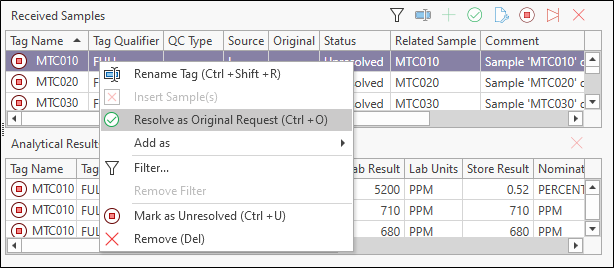
Select the original sample from the list of samples for the despatch:
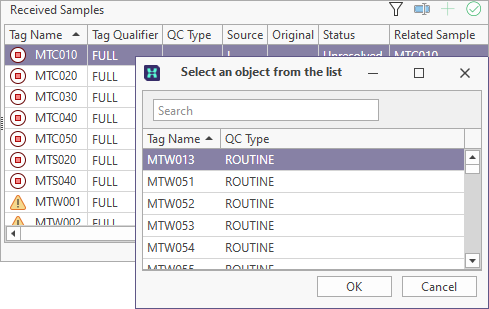
Add as lab check
To identify the unresolved sample as a lab check, right-click and choose the Add as lab check option from the right-click menu.
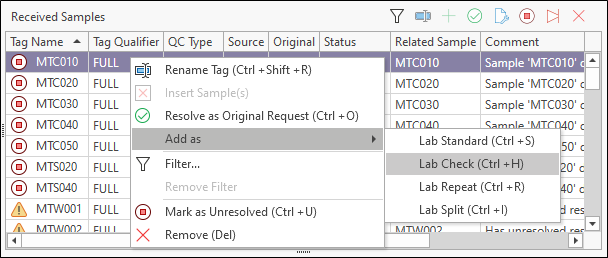
The lab check must be linked to the original sample on which the check sample was based.
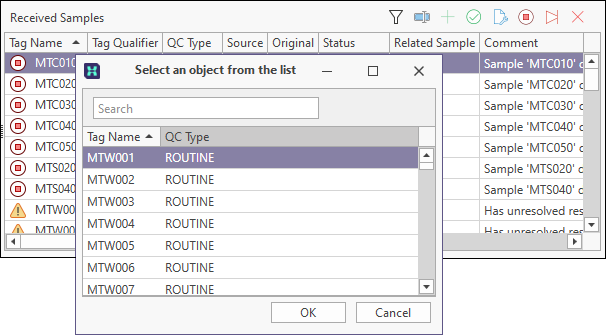
Add as lab standard
To identify the unresolved sample as a lab standard, simply right-click and choose the Add as Lab Standard option from the right-click menu.

Select the appropriate standard from the list of standards. (This information must be obtained from the laboratory):
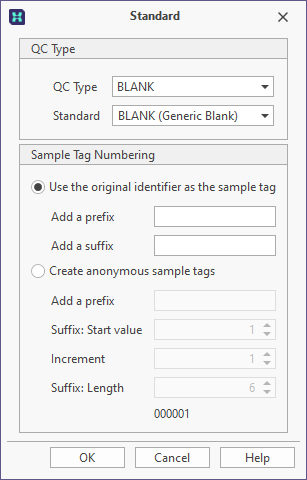
For information about sample tag numbering, refer to Sample Tag Numbering.
Mark as unresolved
Choose the Resolve | Mark as unresolved option to reset the status of the combo to "Unresolved".
Unresolved samples are ignored during further processing.